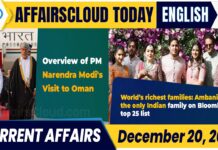 28th Conference of Central and State Statistical Organizations (COCSSO), organised by the Ministry of Statistics and Programme Implementation (MoSPI), was held at Dr. Ambedkar International Centre, Janpath, New Delhi, Delhi from 12th to 13th August 2024.
28th Conference of Central and State Statistical Organizations (COCSSO), organised by the Ministry of Statistics and Programme Implementation (MoSPI), was held at Dr. Ambedkar International Centre, Janpath, New Delhi, Delhi from 12th to 13th August 2024.
- The conference was inaugurated by Union Minister of State (MoS) (Independent Charge) Rao Inderjit Singh, MOSPI.
- The theme of discussion of the conference was “Use of Data for Decision Making: Strengthening State Statistical Systems”.
Note: The 27th COCSSO was organized in Kolkata West Bengal in 2019 on the theme ”Sustainable Development Goals (SDGs)’
About 28th COCSSO:
Aim: To facilitate the exchange of ideas, best practices, and discussions on common issues and the way forward.
Participants: Representatives from over 30 Central Ministries/Departments, around 29 State/UT Governments, organizations such as Mumbai, Maharashtra-based Reserve Bank of India (RBI), Kolkata,West Bengal (WB)-based Indian Statistical Institute (ISI), United Nations (UN) agencies, among others.
Highlights:
i.It provided a platform for discussion and coordination between Central and State Statistical Organizations to enhance the efficiency of the Indian Statistical System through collaboration.
ii.Various topics including Agriculture and Livestock, SDGs, Sample Surveys, National & Regional Accounts, Statistical Strengthening of States, Internal Quality Assessment Framework, Consumer Price Index, Social Statistics, Capacity Building, Economic Census & Enterprise Surveys, Environment Statistics, Data & Meta Data Standards, Infrastructure & Project Monitoring, Data Dissemination, etc were dicussed during the conference.
Key Points:
i.A need for district-level statistics for primary economic indicators and more frequent Periodic Labour Force Surveys (PLFS), including rural job data was highlighted.
ii.Emphasizing were laid on greater coordination between Centre and States/Union Territories (UTs) to meet the increasing demand for data.
iii.MoSPI’s recent Initiatives include the e-Sankhiyiki portal as a data repository, the Research and Analysis Unit for data-driven policy insights, the Data Innovation Lab, and Data Users’ conferences, among others.
Release of Publication “Women and Men in India 2023”
“Women and Men in India, 2023”, the 25th issue of the annual publication ‘Women and Men in India’ by MoSPI, was released during the conference. It provides a comprehensive view of the status of women and men across India, covering topics like Population, Education, Health, Economic Participation, and Decision-Making Involvement.
- It includes gender-disaggregated data and highlights key achievements in gender equality, including SDG indicators.
Gist of the report:
i.Maternal Mortality Ratio (MMR): Reduced from 254 per lakh live births in 2004-06 to 97 in 2018-20.
- Under-5 Mortality Rate: Decreased from 43 in 2015 to 32 in 2020.
- Infant Mortality Rate (IMR): Equalized between male and female at 28 per 1000 live births in 2020.
ii.Labour Force Participation Rate (LFPR): Male LFPR rose from 75.8% to 78.5%, and female LFPR from 23.3% to 37% between 2017-18 and 2022-23.
iii.India’s population is projected to reach 152.2 crores, with women comprising 48.8% of the total. The sex ratio is expected to improve from 943 in 2011 to 952 by 2036.
iv.Age Specific Fertility Rate (ASFR): It is reduced in the 20-24 and 25-29 age groups, while increased in the 35-39 age group.
v.Adolescent Fertility Rate: It is lower for the literate population (11.0) compared to the illiterate (33.9) in 2020.
vi.Women’s Voter Turnout: For the first time, women surpassed men at 67.2% in the 2019 national elections.
vii.Women-led Startups: 47.6% of the 1,17,254 startups recognized by DPIIT since 2016 are led by women.
About COCSSO:
i.COCSSO was first organized in 1971 as a platform for Central and State Statistical Organizations to discuss statistical issues, provide an overarching perspective on statistical system development, and make recommendations on improving the system.
- Earlier it was supposed to be organized once in every 2 years but later it has been decided have it every year.
ii.It addresses technical issues in statistics, sets up working groups for specific statistical tasks, and provides guidelines for data collection.
iii.The council reviews the role of Statistical Advisers in government bodies and considers the Action Taken Report on recommendations from previous meetings to ensure continuous improvement.
Recent Related News:
i.The Union Minister of State (MoS) (Independent Charge) Rao Inderjit Singh, MoSPI has launched the MPLADS e-SAKSHI Mobile Application (app) in New Delhi, Delhi. The app aims to enhance transparency, accessibility, and efficiency in the execution of Member of Parliament Local Area Development (MPLAD) Scheme-2023.
ii.The National Statistical Office (NSO), MoSPI released the First Advance Estimates (FAE) of National Income for the financial year 2023-24, both at Constant (2011-12) and Current Prices. As per it, Indian economy growth in real GDP will be at 7.3% in FY24 as compared to the 7.2% in FY23.
About Ministry of Statistics & Programme Implementation (MoSPI):
MoSPI came into existence as an Independent Ministry in 1999 after the merger of the Department of Statistics and the Department of Programme Implementation
Minister of State (MoS)– Rao Inderjit Singh (Constituency- Gurugram, Haryana)




